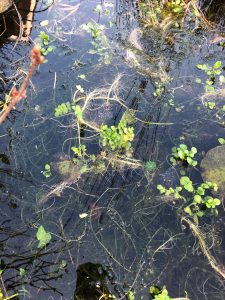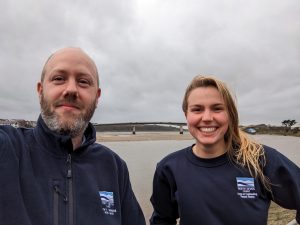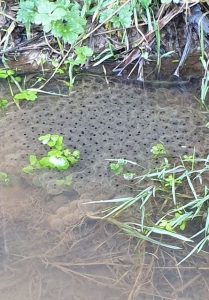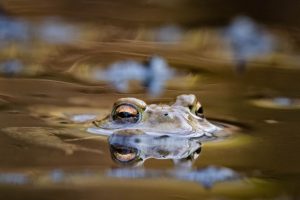Cornwall and Devon add first records to 2023 PondNet Spawn Survey
13th January 2023
The season’s first sightings of frog spawn have been added to an annual national survey, with the first entry being from the Isles of Scilly on 23 December. Led by national wildlife conservation charity Freshwater Habitats Trust, the PondNet Spawn Survey maps sightings of Common Frog and Common Toad spawn across the country to better understand how amphibians use different types of waterbodies to breed.
The first data was added by Carole Cilia, who spotted frog spawn in her garden pond on St Mary’s two days before Christmas. This was followed by two sightings in North Devon early in the New Year.
Freshwater Habitats Trust has been collecting data on sightings of breeding frogs and toads since 2012. Each year since then, people across the country have got involved by recording spawn they have spotted in their garden or community ponds, or in the countryside.
Anyone can upload PondNet Spawn Survey data, adding a grid reference, the nearest postcode or using the What3Words app. The charity is also encouraging people to share photographs of frog and toad spawn they have spotted on social media, using the hashtag #SpawnSurvey
 The first 2023 PondNet Spawn Survey entry was from a garden pond on the Isles of Scilly. Photo: Carole Cilia
The first 2023 PondNet Spawn Survey entry was from a garden pond on the Isles of Scilly. Photo: Carole Cilia
Carole Cilia, who submitted the first records for the 2023 survey, said: “The Isles of Scilly has a temperate climate so we often see signs of Spring before the rest of the country. There is very little freshwater on the islands as most pools are brackish and each year our wildlife pond is visited by frogs, who seem desperate for somewhere to spawn. For some unknown reason, ours always seems to be the first pond on the island to have frog spawn!
“As keen birders and nature lovers, my husband and I appreciate how important it is to keep records of wildlife so we’re pleased to be able to help with the 2023 PondNet Spawn Survey.”
Joe Newberry added to the 2023 PondNet Spawn Survey after seeing clumps of frog spawn in a pond on the National Trust’s Brownsham site in the North Devon Coast AONB on 5 January. Joe is Coordinator of National Lottery Heritage Fund project Finding Nature’s Footprints, which connects people to nature and invites them to take part in wildlife surveys. He had been encouraging local people to get involved in the PondNet Spawn Survey when he spotted the spawn.
 Joe Newberry with his colleague Lowenna Arnold.
Joe Newberry with his colleague Lowenna Arnold.
Joe said: “I am keen to get local people involved in the PondNet Spawn Survey. It’s not just an important way for us to understand more about how amphibians are breeding here in the UK, it’s also a really great opportunity to get outside and discover local wildlife.
“Finding Nature’s Footsteps is all about connecting people with the amazing wildlife and diverse habitats in the North Devon Coast AONB and we’ll be running lots of surveys and volunteering opportunities later in the year. I hope these early sightings in North Devon will encourage people to go out spawn spotting and get involved with the 2023 PondNet Spawn Survey.”
Just a few miles west, Clare Gurton added her spawn sighting to the survey after noticing frog spawn in a field ditch near Hartland on 7 January. Clare was out litter picking in the area, where she runs a local group called Hartland’s Nature, when she noticed the spawn.
 Spawn in Hartland, North Devon. Photo: Clare Gurton.
Spawn in Hartland, North Devon. Photo: Clare Gurton.
Freshwater Habitats Trust Director of Policy and Research Dr Naomi Ewald said: “Frog or toad spawn is one of the first signs of spring and it’s always really exciting to see the first entries to our PondNet Spawn Survey. The first sightings are almost always in Cornwall and Devon and this year is no exception with a very early, pre-Christmas sighting on the Isles of Scilly – the most southerly point of Britain.
“It will be fascinating seeing entries from further north appearing on our survey over the coming weeks.
“Frogs and toads are amphibians and live on land for much of the year, but they rely on having access to ponds and other waterbodies to breed. Projects like the PondNet Spawn Survey are helping us to understand more about how frogs and toads use a range of different types of waterbodies to breed. We always get a very positive response to our Spawn Survey and are very grateful to everyone who takes part.”
Spawn facts
-
- Amphibians live on land for much of the year, but return to ponds to breed in spring. This means waterbodies can become extremely crowded.
- Frog spawn is laid in big clumps, whereas toad spawn forms long chains.
- Toad spawn is generally laid in deeper water than frog spawn.
- A single frog or toad will lay thousands of eggs. This is because eggs and tadpoles are very vulnerable to predators, so only a few will survive and become adults.
- It takes between two and four weeks for spawn to hatch and tadpoles to emerge.

